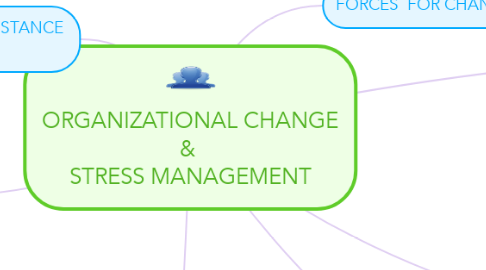
1. individuals with a positive self-concept and high risk tolerance coped better with organizational change
2. Manipulation & Cooptation
2.1. manipulation - covert influence attempts
2.1.1. Twisting facts to make them more attractive
2.1.2. withholding information
2.1.3. creating false rumors to get employees to accept change
2.2. cooptation - combines manipulation & participation
2.2.1. “buy off” the leaders of a resistance group by giving them a key role, seeking their advice not to find a better solution but to get their endorsement
3. OVERCOMING RESISTANCE FOR CHANGE
3.1. Education & Communication
3.1.1. fights the effects of misinformation and poor communication
3.1.2. help “sell” the need for change by packaging it properly
3.2. Participation
3.2.1. reduce resistance
3.2.2. obtain commitment
3.2.3. increase the quality of the change decision
3.3. Building support & Commitment
3.3.1. counseling and therapy
3.3.2. new-skills training
3.3.3. a short paid leave of absence
3.3.4. firing up employees and emphasizing their commitment to the organization
3.4. Develop positive relationships
3.4.1. People are more willing to accept changes if they trust the managers implementing them
3.5. Implementing changes fairly
3.5.1. important when employees perceive an outcome as negative, so it’s crucial that employees see the reason for the change and perceive its implementation as consistent and fair
3.6. Selecting people who accept change
3.6.1. Individuals higher in general mental ability are able to learn and adapt to changes in the workplace
3.6.2. teams that are strongly motivated by learning about and mastering tasks are better able to adapt to changing environments.
3.7. Coercion
3.7.1. the application of direct threats or force on the resisters.
3.7.1.1. threats of transfer
3.7.1.2. loss of promotions
3.7.1.3. negative performance evaluations
3.7.1.4. a poor letter of recommendation
4. liberalization of attitudes toward gay, lesbian & transgender employees
5. increased government awareness
6. negative social attitudes toward business & executives
7. FORCES FOR CHANGE
7.1. Nature of the workforce
7.1.1. example
7.1.1.1. multicultural environment
7.1.1.2. demographic changes
7.1.1.3. immigration
7.1.1.4. outsourcing
7.2. Technology - continually changing jobs & organizations
7.2.1. example
7.2.1.1. faster, cheaper, more mobile computers & handheld devices
7.2.1.2. emergence & growth of social networking sites
7.2.1.3. deciphering of human genetic codes
7.3. Economic shocks
7.3.1. example
7.3.1.1. rise & fall of global housing market
7.3.1.2. financial sector collapse
7.3.1.3. global recession
7.4. Competition
7.4.1. example
7.4.1.1. global competitors
7.4.1.2. mergers & consolidation
7.4.1.3. increased government regulation of commerce
7.5. Social trends
7.5.1. example
7.5.1.1. more multitasking & connectivity
7.6. World politics
7.6.1. example
7.6.1.1. rising healthcare cost
7.6.1.2. opening of new markets worldwide
